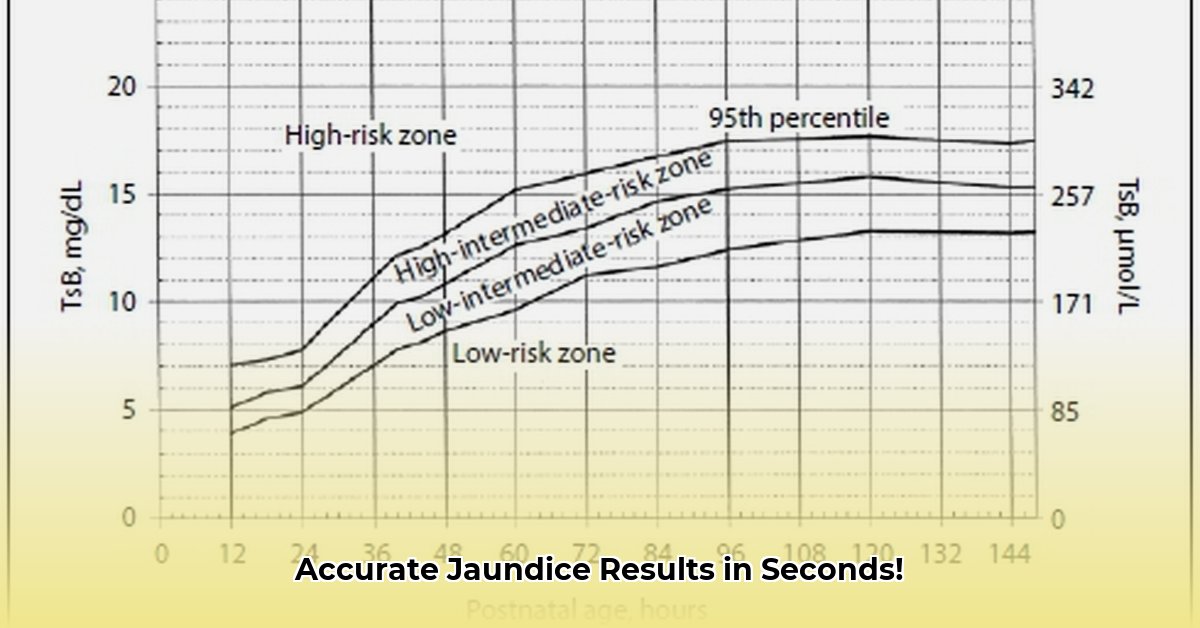Worried about jaundice in your newborn? You’re not alone. Jaundice is common, but getting an accurate reading quickly is key to your baby’s health. This article explains a painless way to check for jaundice called a transcutaneous bilirubin (TcB) scan – technology for newborn care. We’ll compare it to the blood test method and show you how it works, including expert tips for the best results. We’ll cover what makes a good TcB reading, how to manage jaundice, and ensure your baby gets the best care. Transcutaneous bilirubinometry offers a quick, non-invasive alternative to painful blood draws. Learn more about TcB devices like the Bilirubinometer.
Transcutaneous Bilirubin Scan: A Speedy Check for Newborn Jaundice
Jaundice – that yellowish tint to a baby’s skin – is a common concern for new parents. Traditionally, checking for jaundice meant a tiny needle prick to get a blood sample. Now there’s a gentler way: the transcutaneous bilirubin scan, or TcB. A quick, painless scan instead of a blood test! Let’s dive into this technology, especially its role in newborn screening programs and its convenience for parents.
How a Transcutaneous Bilirubin Scan Works
The TcB uses a handheld device that shines a light on your baby’s skin. This light measures the amount of bilirubin, a yellowish substance, under the skin. It’s a non-invasive window into your baby’s health, providing information without needles. The device displays the bilirubin level almost instantly, providing peace of mind for parents and healthcare professionals.
How Accurate is This Jaundice Test?
The accuracy of a TcB is usually high, particularly when detecting moderate jaundice. Many studies show it’s very reliable in determining if a newborn needs further attention. Its accuracy can be slightly less precise when bilirubin levels are extremely high. In those situations, a traditional blood test is usually done to get a more precise reading. The TcB serves as a first check, a preliminary screening, but a blood test might be necessary to confirm the results, especially when assessing accuracy.
The Upsides of a Quick Bilirubin Scan
- Speed and Ease: You get results immediately.
- Gentle for Baby: No needles mean less discomfort for your little one and less stress for you.
- Cost Savings: The reduced need for blood tests can translate to lower overall healthcare expenses.
- Convenient Testing: Perfect for any setting – from busy hospital nurseries to smaller clinics, even in remote areas.
The Downsides: What to Keep in Mind
- Accuracy Changes: How accurate the reading is can vary depending on things like your baby’s skin tone, gestational age, and if they’re under phototherapy (light therapy for jaundice).
- Standardization Issues: There’s not one single, universal approach to interpreting the results. Different devices and healthcare providers may use slightly different guidelines.
- Confirmation Sometimes Needed: If the bilirubin level is high or if there’s uncertainty, a blood bilirubin test is essential for a firm diagnosis.
The Future of TcB and Ongoing Research
Scientists are continually refining this technology. They’re focusing on improving the accuracy even more and getting everyone to agree on a single universal way of interpreting the results. The ultimate goal is a simple, reliable, accessible test available to every newborn worldwide.
Who Benefits? Everyone!
Newborns benefit from quicker, less stressful jaundice screening. Parents get a reduction in anxiety. Healthcare professionals gain efficiency and a smoother workflow. In short, we’re ultimately aiming for a healthier start for every baby.
Potential Challenges and How They’re Addressed
| Factor | Potential Impact | Mitigation Strategies |
|---|---|---|
| Device Malfunction | Inaccurate reading, delayed care | Regular maintenance, calibration, and quality checks |
| Interpretation Errors | Misdiagnosis, inappropriate care | Thorough staff training, clear guidelines, double-checking |
| Lack of Universal Standards | Inconsistent results | Ongoing research to establish universal interpretation standards |
The transcutaneous bilirubin scan continues to evolve and improve. It represents a significant development, making newborn care safer, more efficient, and less stressful for everyone involved.
How to Improve Accuracy of Transcutaneous Bilirubinometry in Darker Skin Tones
Accurate jaundice detection in newborns is crucial. Transcutaneous bilirubinometry (TcB) offers a quick, non-invasive alternative to traditional blood tests. But, how to improve accuracy of transcutaneous bilirubinometry in darker skin tones is a major challenge. Melanin, the pigment responsible for skin color, absorbs light differently than lighter skin, affecting the accuracy of TcB readings. This leads to underestimation, potentially delaying necessary treatment.
Understanding the Challenges
Melanin is a key factor impacting TcB accuracy. Melanin, the pigment responsible for skin color, absorbs light differently than lighter skin, affecting the accuracy of TcB readings.
Strategies for Enhanced Accuracy
Several approaches are being pursued to address this issue.
- Advanced Device Algorithms: Newer TcB devices incorporate algorithms designed to compensate for variations in skin pigmentation.
- Rigorous Quality Control (QC): Implementing strict QC protocols is essential, including regular calibration checks.
- Improved Calibration Methodologies: The development and use of calibration materials specifically designed to mimic the optical properties of darker skin tones is crucial.
- Machine Learning Integration: Machine learning algorithms show potential to analyze factors like skin tone and adjust TcB measurements accordingly.
- Training and Standardization: Clinicians need thorough training on proper TcB device operation and result interpretation.
The Role of Healthcare Providers
Healthcare professionals play a key role in improving TcB accuracy.
- Careful Interpretation: Clinicians should carefully interpret TcB results, especially in darker-skinned infants.
- Supplemental Blood Tests: If there’s uncertainty about a TcB reading, a traditional serum bilirubin test (TSB) should be ordered.
- Active Participation in Quality Improvement Efforts: Healthcare systems should actively participate in research and quality improvement initiatives to improve TcB technology and protocols.
The Future of TcB
The development of new technologies and algorithms continues at a rapid pace. We can anticipate significant improvements in TcB accuracy in the coming years.
TcB Integration with Electronic Health Record Systems for Streamlined Workflow
Non-invasive transcutaneous bilirubin (TcB) measurements offer a faster, less painful alternative to traditional blood tests for assessing jaundice in newborns. Integrating TcB technology with Electronic Health Record (EHR) systems, like the features in BiliTool, improves workflow efficiency. TcB Integration with Electronic Health Record Systems for Streamlined Workflow streamlines newborn care.
Understanding Transcutaneous Bilirubin (TcB) Measurements
Imagine a quick, painless way to check a baby’s bilirubin levels – no more needles! That’s the promise of TcB. This non-invasive method uses a handheld device to measure bilirubin levels through the skin.
Why Integrate TcB with EHR Systems?
Efficient workflow is key in neonatal care. Integrating TcB data directly into an EHR system streamlines the process from measurement to documentation.
The Benefits of Streamlined Workflow
- Faster Diagnosis and Treatment: Quick access to TcB readings enables prompt intervention.
- Reduced Discomfort for Infants: Fewer blood tests mean less stress and pain for the newborns.
- Improved Efficiency: Healthcare providers save time and resources.
- Better Data Management: Centralized data storage improves tracking and analysis of bilirubin levels over time.
Addressing Potential Challenges
While TcB offers advantages, we should also acknowledge potential limitations. Factors like skin pigmentation and hydration can affect the accuracy of TcB readings.
The Role of BiliTool and Similar Systems
BiliTool exemplifies successful TcB Integration with Electronic Health Record Systems for Streamlined Workflow. Its features, such as sequential bilirubin result display for trend analysis and a convenient “copy to clipboard” function, are valuable.
- Choosing the Right Portable Hydro Turbine for Your Needs - December 14, 2025
- Best Portable Hydro Generators for Off-Grid and Outdoor Power - December 13, 2025
- Choosing the Right Generator with Water for Off-Grid Power - December 12, 2025
















